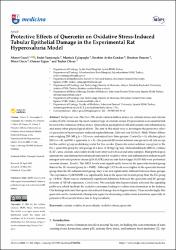| dc.contributor.author | Güzel, Ahmet | |
| dc.contributor.author | Yunusoğlu, Sedat | |
| dc.contributor.author | Çalapoğlu, Mustafa | |
| dc.contributor.author | Candan, İbrahim Aydın | |
| dc.contributor.author | Onaran, İbrahim | |
| dc.contributor.author | Öncü, Meral | |
| dc.contributor.author | Ergün, Osman | |
| dc.contributor.author | Oksay, Taylan | |
| dc.date.accessioned | 2022-09-23T14:00:08Z | |
| dc.date.available | 2022-09-23T14:00:08Z | |
| dc.date.issued | 2021 | en_US |
| dc.identifier.uri | https://hdl.handle.net/20.500.12868/1670 | |
| dc.description.abstract | Background and Objectives: The most common kidney stones are calcium stones and calcium oxalate (CaOx) stones are the most common type of calcium stones. Hyperoxaluria is an essential risk factor for the formation of these stones. Quercetin is a polyphenol with antioxidant, anti-inflammatory, and many other physiological effects. The aim of this study was to investigate the protective effect of quercetin in hyperoxaluria-induced nephrolithiasis. Materials and Methods: Male Wistar-Albino rats weighing 250-300 g (n = 24) were randomized into three groups: Control (n = 8), ethylene glycol (EG) (n = 8), and EG + quercetin (n = 8). One percent EG-water solution was given to all rats except for the control group as drinking water for five weeks. Quercetin-water solution was given to the EG + quercetin group by oral gavage at a dose of 10 mg/kg/day. Malondialdehyde (MDA), catalase (CAT), urea, calcium, and oxalate levels were analyzed in blood and urine samples. Histopathological assessments and immunohistochemical analyses for oxidative stress and inflammation indicators p38 mitogen-activated protein kinase (p38-MAPK) and nuclear factor kappa B (NF-kB) were performed on renal tissues. Results: The MDA levels were significantly lower in the quercetin-treated group than in the EG-treated group (p = 0.001). Although CAT levels were higher in the quercetin-treated group than the EG-administered group, they were not significantly different between these groups. The expression of p38 MAPK was significantly less in the quercetin-treated group than the EG group (p < 0.004). There was no statistically significant difference between the quercetin and EG groups in terms of NF-kB expression. Conclusions: We conclude that hyperoxaluria activated the signaling pathways, which facilitate the oxidative processes leading to oxalate stone formation in the kidneys. Our findings indicated that quercetin reduced damage due to hyperoxaluria. These results imply that quercetin can be considered a therapeutic agent for decreasing oxalate stone formation, especially in patients with recurrent stones due to hyperoxaluria. | en_US |
| dc.language.iso | eng | en_US |
| dc.relation.isversionof | 10.3390/medicina57060566 | en_US |
| dc.rights | info:eu-repo/semantics/openAccess | en_US |
| dc.subject | Calcium oxalate | en_US |
| dc.subject | Hyperoxaluria | en_US |
| dc.subject | Oxidative stress | en_US |
| dc.subject | Quercetin | en_US |
| dc.title | Protective effects of quercetin on oxidative stress-induced tubular epithelial damage in the experimental rat hyperoxaluria model | en_US |
| dc.type | article | en_US |
| dc.contributor.department | ALKÜ, Fakülteler, Tıp Fakültesi, Temel Tıp Bilimleri Bölümü | en_US |
| dc.identifier.volume | 57 | en_US |
| dc.identifier.issue | 6 | en_US |
| dc.relation.journal | Medicina-Lithuania | en_US |
| dc.relation.publicationcategory | Makale - Uluslararası Hakemli Dergi - Kurum Öğretim Elemanı | en_US |


















